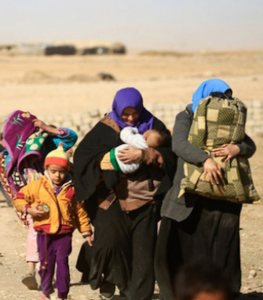New focus on IDPs
Refugees and asylum seekers have been the subjects of political discussion, law making and even two UN member states endorsed landmark “compacts” in recent years.
 But a third group of displaced people attracts much less attention. These are internally displaced persons, or ‘IDPs’ – and there are now a staggering 41.3 million of them globally.
But a third group of displaced people attracts much less attention. These are internally displaced persons, or ‘IDPs’ – and there are now a staggering 41.3 million of them globally.
Now, a High-level Panel on IDPs is set to become a reality after 37 nations sent a letter to UN Secretary-General António Guterres requesting he establish one.
Since then, nearly 60 governments have endorsed this call, including a number of states with IDPs.
Humanitarian agencies say action is needed as IDPs face serious and growing challenges in many different locations and contexts around the globe.
Government pressure for premature returns and restricted access to aid pervades the response to conflict displacement in Ethiopia, the agencies – including Oxfam, Save the Children and the International Rescue Committee, say.
South Sudanese IDPs face potential camp closures at UN protection sites before clear plans for safe, voluntary, and dignified returns are in place.
In the Central African Republic, IDPs have been pressed to return to their home areas before those locations are deemed safe. And in Colombia, despite the continuing needs of the 7.7 million IDPs, attention and resources have shifted to Venezuelan refugees and migrants.
According to the ‘Guiding Principles’ on Internal Displacement – international standards adopted 21 years ago – states bear the ultimate responsibility for the well-being of people displaced within their borders.
However, governments are often unable or unwilling to respond effectively. In some cases, such as Syria, they are the cause of internal displacement.
Agencies say weaknesses in the international humanitarian system also contribute to inadequate IDP response. Although multiple agencies engage in IDP assistance, there is a clear lack of accountability within the system to stand up for the rights and protection of IDPs.
Also, responses to IDP crises are usually significantly underfunded by donor governments, the agencies says.
In the past year there have been several initiatives aimed at improving protection, assistance, and solutions for IDPs.
The UN Refugee Agency is set to launch a new, revised policy that elevates the agency’s IDP protection role within its country operations.
The UN’s GP20 Plan of Action is a three-year plan to promote best practices among all involved in IDP response while calling for enhanced efforts to create national laws and policies on internal displacement.
Also, the World Bank, which recently established new financing mechanisms to support refugees and the communities that host them, is exploring opportunities to bring its development expertise to IDP situations.
Observers say that while these initiatives are important, they are not likely to lead to robust changes in a system in serious need of coordinated reform.
At the very least, the creation of a High-Level Panel on IDPs would help focus global attention on the internal displacement challenges faced by so many individual countries and a growing underserved population group.
A High-Level Panel would not immediately solve this major, complex, multi-faceted global crisis, but it might turn the spotlight on the issue.
Importantly, the creation of a panel may pull together the most promising elements of ongoing disparate initiatives, while introducing and integrating their own ideas into an actionable and coordinated agenda for change – one backed by the political weight of the UN secretary-general.












